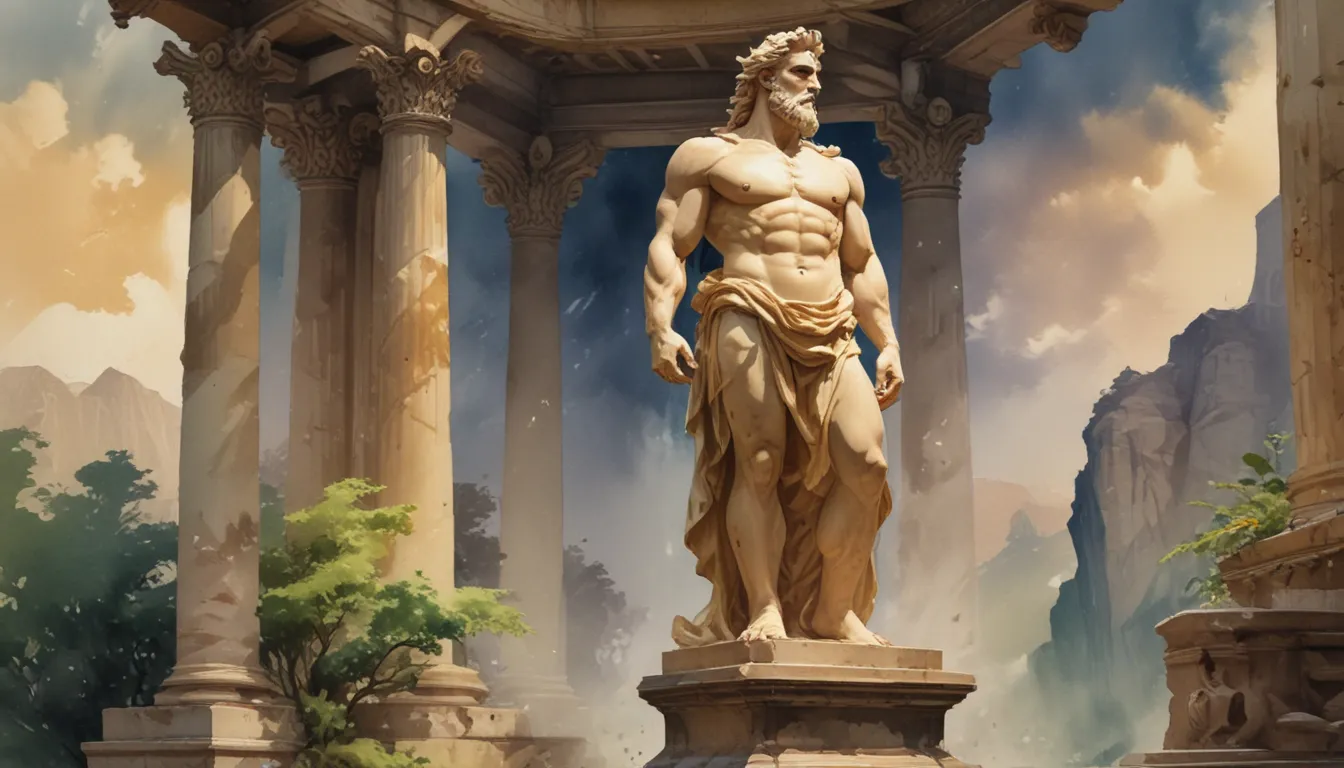The images in our articles are for illustrative purposes only and may not exactly match the content. They are intended to capture your interest and complement the text, not to replace it.
Have you ever wondered about the wonders of the ancient world that continue to captivate our imagination even today? The Zeus statue, also known as the Statue of Zeus at Olympia, is one such marvel that stands tall as a testament to the artistic brilliance of the ancient Greeks. Crafted by the renowned sculptor Phidias around 435 BC, this colossal statue embodies the awe-inspiring power and magnificence of the Greek god Zeus.
In this article, we will unravel 13 mind-blowing facts about the Zeus statue that will leave you in awe of its grandeur and legacy. From its historical significance to its influence on art and culture, each detail paints a vivid picture of this iconic landmark that continues to inspire admiration and fascination.
The Zeus Statue: A Glimpse into Ancient Glory
The Zeus Statue, deemed one of the Seven Wonders of the Ancient World, was created by the skilled hands of the Greek sculptor Phidias in the 5th century BC. Its monumental size and intricate details speak volumes about the craftsmanship and artistic vision of the ancient Greeks.
Depicting the King of Gods
At a towering height of approximately 42 feet (13 meters), the Zeus Statue represents the powerful Greek deity, Zeus, the king of gods. Sculpted in a seated position, Zeus holds a scepter in one hand and an image of Nike, the goddess of victory, in the other, exuding a sense of authority and majesty.
Residing in the Temple of Zeus
The Zeus statue found its home in the Temple of Zeus in the ancient city of Olympia, Greece. This grand setting was specifically constructed to house the magnificent sculpture, drawing in crowds of worshippers and visitors who marveled at its splendor.
Symbol of Power and Might
Beyond its religious significance, the Zeus statue symbolized the power and might of the Greek empire. It served as a tangible reminder of Zeus’ authority and the strength of Greek civilization during its golden age.
Crafted with Precision and Dedication
Phidias dedicated nearly a decade of his life to creating the Zeus statue, meticulously shaping every detail to ensure its longevity and grandeur. His exceptional skill and commitment to perfection are evident in the statue’s enduring legacy.
Tragic End and Lasting Legacy
Despite its colossal presence, the Zeus Statue met a tragic fate when the Temple of Zeus succumbed to fire in the 5th century AD, reducing the statue to ashes. However, its influence on art, architecture, and modern culture continues to reverberate through the ages.
Rediscovering the Zeus Statue
Archaeological excavations in Olympia have unearthed fragments and remnants of the Zeus Statue, offering valuable insights into its original form and significance. These discoveries allow us to piece together the puzzle of this magnificent ancient wonder.
Face of Wisdom and Serenity
One of the most captivating features of the Zeus statue is its face, which embodies wisdom and serenity. Phidias masterfully captured the essence of the powerful yet peaceful deity, showcasing his artistry and insight.
Enduring Influence on Modern Culture
While the physical presence of the Zeus statue may be lost to time, its legacy lives on in modern culture. Artists, writers, and filmmakers draw inspiration from this ancient masterpiece, weaving its essence into contemporary creations.
Journey to the Past: Tourist Attraction in Ancient Times
In its prime, the Temple of Zeus and the Zeus statue drew crowds of tourists and pilgrims from far and wide. This attraction was a testament to the admiration and reverence people held for the Greek gods and their magnificent representations.
The Zeus Statue’s Absence: A Poignant Reminder
The absence of the Zeus statue serves as a poignant reminder of the fleeting nature of human creations. While we may no longer gaze upon its physical form, the memory and impact of this remarkable masterpiece endure in our collective consciousness.
Conclusion: Embracing the Legacy of the Zeus Statue
As we reflect on the 13 captivating facts about the Zeus statue, we are reminded of its historical, cultural, and artistic significance. From its creation by Phidias to its tragic end, this ancient wonder continues to inspire awe and admiration for ancient craftsmanship and mythology.
Whether you have the chance to witness the Zeus statue in person or explore its legacy through scholarly pursuits, prepare yourself for an extraordinary encounter with one of history’s most remarkable landmarks. The Zeus statue stands as a beacon of human creativity and the enduring allure of ancient civilizations, inviting us to marvel at its grandeur and reflect on the passage of time.
FAQs
-
What is the Zeus statue?
The Zeus statue is a monumental ancient Greek sculpture depicting the king of gods, Zeus, renowned for its grandeur and craftsmanship. -
Where is the Zeus statue located?
The Zeus statue was housed in the ancient city of Olympia in Greece but was tragically destroyed in a fire during the 5th century AD. -
How tall was the Zeus statue?
While the exact height is uncertain, it is believed to have been around 13 meters (42 feet), emphasizing Zeus’ power and majesty. -
What materials were used for the Zeus statue?
Crafted from ivory, gold-plated bronze, and wood, the Zeus statue showcased a rich and majestic appearance befitting its subject. -
Who created the Zeus statue?
The esteemed Greek sculptor Phidias is credited with crafting the Zeus statue, showcasing his exceptional talent and skill. -
Can the Zeus statue be visited today?
While the original statue no longer exists, replicas and recreations can be found in museums and exhibits dedicated to Greek art and history.
Embark on a journey through history and mythology as you explore the fascinating world of the Zeus statue and its enduring legacy. Join us in uncovering the mysteries and marvels of the ancient world, where gods and mortals intertwined in timeless tales of power and beauty.






